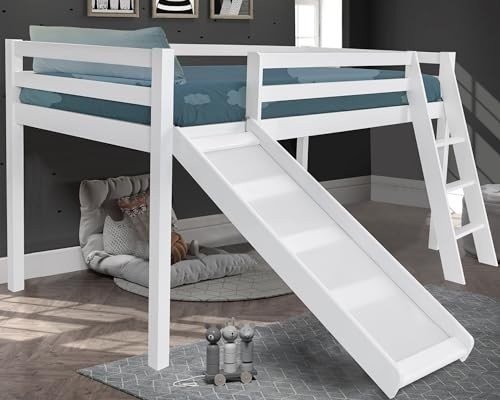The Ultimate Guide to Bunk Beds for Children: Safety, Styles, and Benefits
When it pertains to styling a kid's room, parents frequently deal with the dual challenge of taking full advantage of space while ensuring comfort and functionality. Bunk beds have emerged as a popular solution that attends to these needs, using not simply sleeping arrangements however also adding to a space's visual. In this detailed guide, we will explore different aspects of kids's bunk beds, concentrating on their advantages, safety features, styles, and considerations for moms and dads contemplating this purchase.
Table of Contents
- Advantages of Bunk Beds
- Security Features to Consider
- Types of Bunk Beds
- Design and Style Options
- Upkeep Tips
- Regularly Asked Questions (FAQs)
1. Benefits of Bunk Beds
Bunk beds use many advantages for kids and their parents. Here are some essential benefits:
- Space-Efficiency: Bunk beds are an excellent service for smaller sized spaces. By stacking one bed on top of another, more flooring space is offered for play, storage, or research study areas.
- Affordable: When children share spaces, bunk beds can lower the need for buying 2 separate beds, hence saving cash.
- Promotes Social Interaction: Bunk beds can help siblings or friends bond by sharing a space, producing chances for social development.
- Enjoyable Factor: The concept of sleeping "up high" includes a playful aspect to bedtime, making the shift to sleeping alone much easier for some kids.
- Versatile Design: Bunk beds are available in numerous styles, colors, and designs to match any room style, enabling customization that shows the child's personality.
2. Safety Features to Consider
Safety is paramount when it concerns kids's furniture, especially in the case of bunk beds. Here are some important safety features to assess:
| Safety Feature | Description |
|---|---|
| Strong Construction | Frames made of solid wood or metal are chosen. |
| Guardrails | Ought to be at least 5 inches high and extend along both sides of the upper bunk. |
| Ladder Design | Guarantee ladders are firmly connected and have non-slip steps. |
| Mattress Size & & Fit | Should fit comfortably within the frame to prevent gaps. |
| Weight Limit | Always follow the maker's weight limit recommendations. |
3. Types of Bunk Beds
Bunk beds are available in a number of styles, accommodating numerous requirements, choices, and room sizes. Here are some common types:
- Standard Bunk Bed: The most standard type, with one bed on top of another.
- Loft Bed: Features a high upper bed with space underneath for a desk or play area.
- Futon Bunk Bed: Combines a leading bunk with a futon on the bottom, supplying versatility for seating and sleeping.
- L-Shaped Bunk Bed: This design has the top bunk set at a perpendicular angle to the bottom, producing a small corner area.
- Triple Bunk Bed: Accommodates 3 kids utilizing stacked beds, suitable for large families or sleepovers.
4. Style and Style Options
When it pertains to choosing a design for children's bunk beds, the choices are practically unlimited. Here are some popular designs:
- Traditional Style: Often made of wood, these bunk beds feature elaborate details and are ideal for timeless or rustic-themed spaces.
- Modern Style: Characterized by tidy lines and minimalist designs, modern-day bunk beds can be made of metal or wood.
- Themed Bunk Beds: Some brand names offer bunk beds formed like castles, cars and trucks, or playhouses, making bedtime less of a task.
- Convertible Bunk Beds: These can be separated into 2 private beds, using versatility as children grow.
- Colorful Options: Bunk beds in vibrant colors can add a sense of happiness and playfulness to any space.
5. Upkeep Tips
Maintaining a bunk bed is essential for durability and security. Here are some pointers:
- Regular Inspections: Check for loose screws or bolts every couple of months and tighten them as needed.
- Cleaning up: Wipe down frames regularly to avoid dust accumulation; consider using a vacuum for hard-to-reach areas.
- Mattress Care: Rotate bed mattress regularly and utilize protective covers to lengthen their life.
- Look for Wear and Tear: Look for any indications of damage in the wood or metal and consider replacing parts if required.
- Teach Kids Safety Rules: Encourage kids to use ladders properly and ensure they comprehend the security functions of their bed.
6. Regularly Asked Questions (FAQs)
Q1: What age is appropriate for sleeping in a top bunk?
A1: Typically, kids aged 6 and older are suggested for upper bunk sleeping, as they have the needed motor skills to climb securely.
Q2: Do bunk beds include a mattress?
A2: Most bunk beds are sold as frames just, so you will require to purchase bed mattress separately. Guarantee that the mattress fits the frame comfortably.
Q3: Can bunk beds be separated later on?
A3: Many styles enable conversion into 2 individual beds, supplying versatility for future requirements.
Q4: How can I guarantee my child's security on a bunk bed?
A4: Comply with safety standards and ensure guardrails, a tough frame, and a protected ladder are in location.
Q5: Are there weight limitations on bunk beds?
A5: Yes, always examine the maker's specs relating to weight limitations to make sure safety.
Bunk beds for children can serve numerous purposes while making sure safety and style. With varied Aiden Gore and designs available on the market, parents can discover a system that not just makes the most of bed room space but likewise reflects their kid's unique tastes. Just like any furnishings, understanding security functions, maintenance, and how they fit into a kid's way of life will ensure that these beds stay a practical furnishings service for several years to come.
Through cautious consideration and adherence to safety standards, bunk beds can provide a lasting, enjoyable, and practical sleeping service that kids like.

